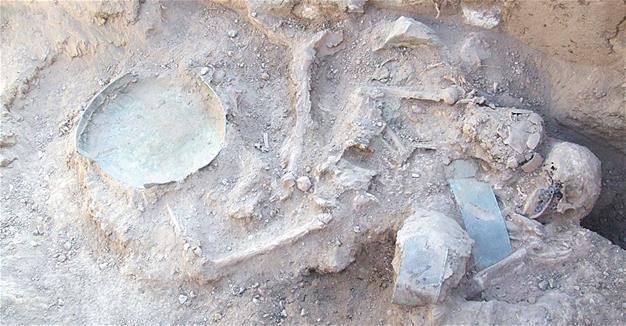Urartian necropolis reveals burial customs
ISTANBUL
 Excavations in a Urartian necropolis in the eastern province of Van’s Çavuştepe Castle, which has been plundered by treasure hunters in recent years, provide important details about Urartian burial customs.
Excavations in a Urartian necropolis in the eastern province of Van’s Çavuştepe Castle, which has been plundered by treasure hunters in recent years, provide important details about Urartian burial customs. The Culture and Tourism Ministry has initiated excavations to rescue the necropolis in the castle. During the excavations, a tomb was unearthed with the skeletons of a man and a woman. Officials believe they were husband and wife because they were buried together.
A bronze belt, tray, seal and several bronze jewelries were also found in the tomb.
Along with the tomb of the wife and husband, a horse skeleton was also found in the search. Officials say it is the first horse skeleton unearthed in a Urartian tomb, making it the most important finding among other discoveries in the castle.
Samples from the horse skeleton will be analyzed to determine the age and species of the horse.
Close to the horse skeleton, the excavation team found many oxidized and deformed iron pieces and bronze nails.
The first observations on the pieces show that these findings may have belonged to a horse carriage.
Preventing illegal excavations
Illegal excavations in the necropolis have so far given extensive damage to the field, erasing the traces of thousands of years of customs.
The main purpose of the recent works was to rescue the necropolis from treasure hunters and also to obtain information about people’s social lives, faiths and burial customs. Two different types of burial methods have been determined in the field.
The first one is the urn-type burial, in which the dead people are cremated and their ashes are buried. Eight urn-type tombs were unearthed in the southern part of the excavation field. The tombs were found in an underground of nearly half a meter depth and most of them were broken.
In the second type of burial method, the dead are placed in a tomb in hocker position, just like in a mother’s womb. The Çavuştepe Castle, where the Urartian people were buried after death, was built in 750 B.C. by the Urartian King Sarduri II. The necropolis in the castle was used by people who lived there for the next 200 years.
Recent excavations in the castle have been carried out by Yüzüncü Yıl University Archaeology Department academic Associate Professor Rafet Çavuşoğlu.
















